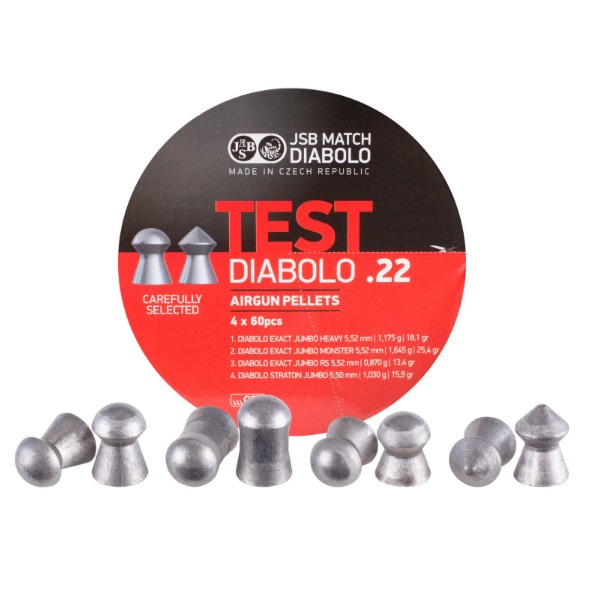If you are new to airgunning, you may not know how important it is to find the right ammo. It starts by understanding what ammo is best suited for a particular purpose. Some ammo, like wadcutter pellets, are ideal for punching paper. Domed pellets are usually best suited for long-range accuracy. Then there is hollow point ammo that’s specifically designed for hunting and so on. So before you go and just add any old tin of pellets to your cart, it’s best to know what will work.
Variety of Options
If you were to count all the various varieties of .22 caliber pellets, your list might include more than 70 or 80 different types. From basic wadcutters to specialty hollow points, the choices can be confusing and seemingly endless. A good general rule of thumb to follow is the adage “you get what you pay for.” It’s not always the case, but most of the time, brands that cost more are made to higher tolerances and are therefore more consistent. Once you’ve identified the right pellet type, i.e., wadcutter, pointed, domed, or hollowpoint, then you can look at options from brands like JSB, RWS, AirArms, and H&N.
Does it really matter?
Airguns can be very particular. The variances on target can be dramatic. Things like twist rate, energy output, and other factors can change how that pellet flies out of the barrel and towards the target. So matching the right pellet to the airgun is critical. Fortunately, here are some guidelines to help you get started in the right direction.
Tip: Match Pellet Weight to Power Output
As you look through all the various pellet options, you may notice that pellet weight can vary wildly.
For example, .177 pellets can start at a mere 4.7 grains and top out at 16 grains. That’s a big difference. A good average weight for a .177 pellet is about 8 grains and is an excellent place to start.
If you are shooting a low powered airgun, a pellet around 7 grains or less may work well. If you are shooting a more powerful .177, then the heavier grain options, something like the H&N Baracuda Match or JSB Heavies may work best.
You’ll find all four types of pellets have options throughout the various pellet weights. There are light wadcutters and heavy wadcutters. The same is true with domed, hollowpoints, and pointed. Once you’ve picked your airgun, and you know what kind of shooting you plan to do, then you can get a good start by looking at pellets in the right “weight class.” Here are some more specific details to help.
Low-Power Airguns
You’ll find lower powered airguns mostly in .177 and some in .22. A low powered .177 airgun generally tops out at 10 to 12-foot pounds of energy and will often shoot .177 pellets in the 7 to 9 grain category pretty well. A low powered .22 also produces about 10 to 12 foot-pounds. .22 caliber pellets can range from about 9 grains all the way up to 34 grains.
While the difference is even more dramatic, the principle remains the same.
Average Airguns
The average energy you should see from a .177 airgun is around 15 to 18 foot-pounds. When you get closer to 20 foot-pounds in a .177, you are reaching the upper end. As with pellet weight, the energy output from .22 caliber airguns is wider. The average .22 airgun starts at about 15 foot-pounds and goes up nearer to 40 foot-pounds. When you get above 40 foot-pounds, then you are looking at a magnum .22 airgun.
If you have a normal .177, look at pellets in the 8 to 10 grain weight class. For average powered .22 airguns, take a look at 14 grain up to 21 grain pellets. Most of your pellet options will fit in these ranges.
Magnum-Power Airguns
If your airgun is shooting above 18 foot-pounds in .177 and above 40 foot-pounds in .22, then congratulations. You have a magnum powered airgun! You can start looking at some of the heavier pellet options.
The main advantage will be that the heavier pellets tend to be more stable in the wind and also tend to hold their energy further downrange. Of course, pellet shape and type also play a big role.
In .177, take a look at pellets over 10 grains, and in .22, look for pellets over 20 grains. You may find that the added weight helps with accuracy and energy on target.
Finding the Best Pellet
One of the best ways to find the best pellet is to invest in pellet samplers. Most of the top-tier pellet makers offer these samplers. With these samplers, airgunners can test various pellets without having to buy full tins that may not work. JSB, H&N, Gamo, and RWS have various sample packs that can help you get started. Many will have pellets spanning the various weight classes and will help you quickly and easily find the best ammo for your airgun!
If you need help dialing in the best option for you, then don’t hesitate to give us a ring here at Airgun Depot. We are always here to help.
